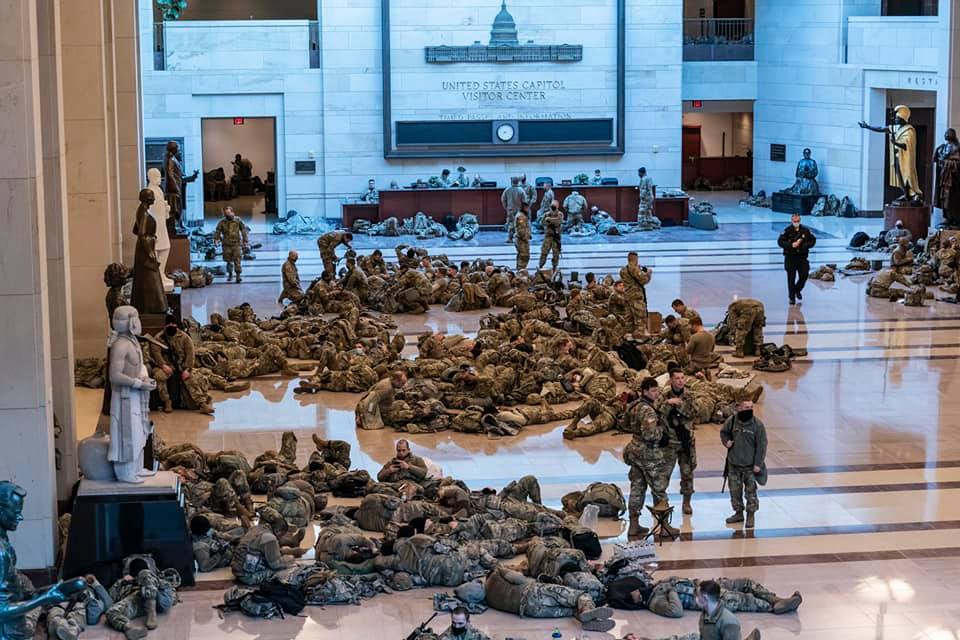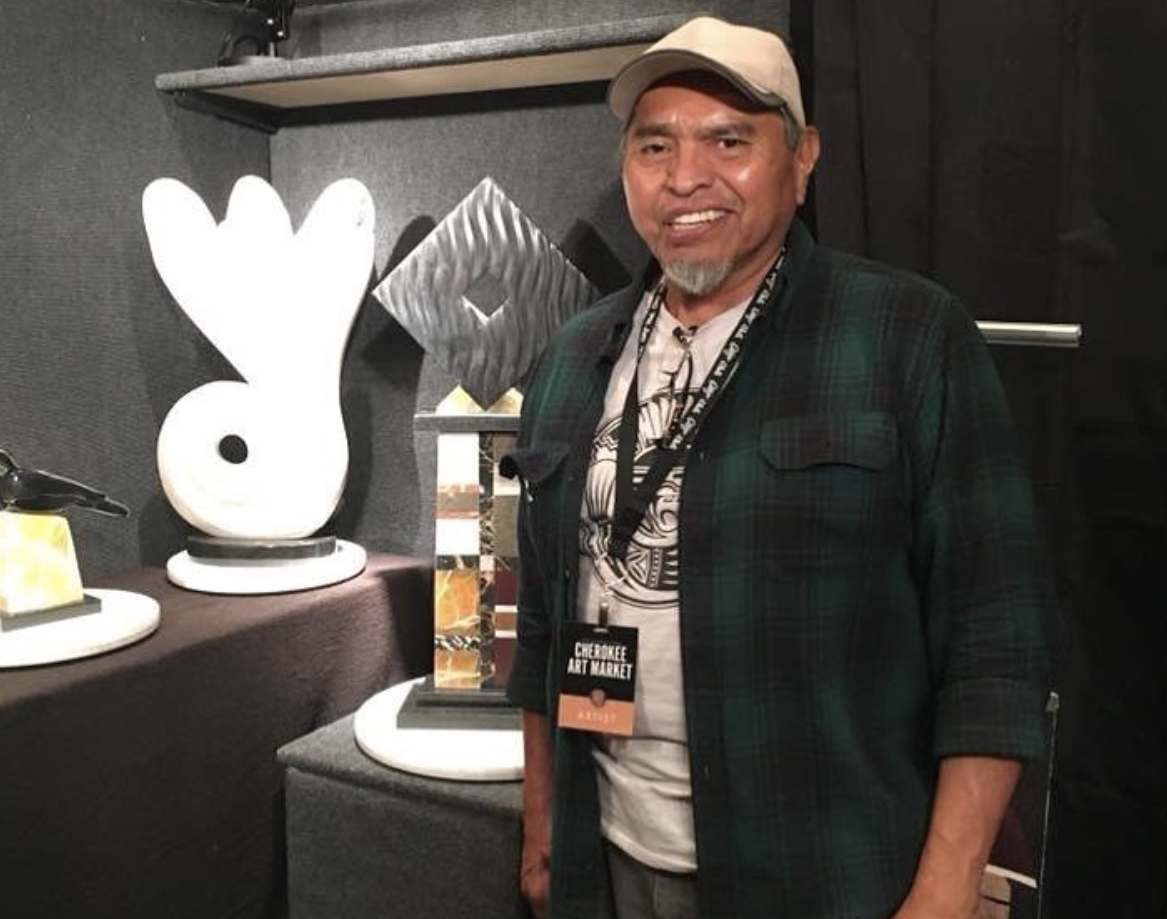
- Details
- By Native News Online Staff
WASHINGTON — Jemez Pueblo sculptor Cliff Fragua, 65, called officials at the U.S. Capitol after last Wednesday’s Capitol riot that left the building trashed, dozens of people injured and five people dead. Fragua had good reason to be concerned because a statue of Po’Pay, which he carved, is on display in the Capitol.
He was told the marble sculpture was of Po'pay, a pueblo Indian who conspired to drive the Spanish from what is now New Mexico nearly 100 years before the better-known American revolution began, was not damaged.
 Cliff FraguaOn FGFrallllllllllllFFFOn Wednesday morning, Fragua reeived a Tweet showing national guard members, who are assigned to protect the Capitol, lying on the cold marble floors of the U.S. Capitol Visitor Center, some under the Po’Pay statue. Several thousand national guard members are in Washington, D.C. in preparation for next week’s inauguration on Jan. 20, 2021 of Joseph Biden, who will be sworn-in as the 46th president of the United States at noon. It is the first time since the Civil War soldiers have slept inside the Capitol.
Cliff FraguaOn FGFrallllllllllllFFFOn Wednesday morning, Fragua reeived a Tweet showing national guard members, who are assigned to protect the Capitol, lying on the cold marble floors of the U.S. Capitol Visitor Center, some under the Po’Pay statue. Several thousand national guard members are in Washington, D.C. in preparation for next week’s inauguration on Jan. 20, 2021 of Joseph Biden, who will be sworn-in as the 46th president of the United States at noon. It is the first time since the Civil War soldiers have slept inside the Capitol.
“When I saw the photograph this morning, I realized how powerful it all was. I feel it is appropriate they were there under Po’Pay because the message he conveyed about defending his culture and people. Today, our national guard is protecting and caring for our democracy,” Fragua told to Native News Online from his home on the Jemez Pueblo.
“Po’Pay stood up against tyranny and this is what we need now in this country. We need people to stand up against tyranny,” Fragua said. “We, as Native people believe in the Constitution even though we are referred to as savages in the Declaration of Independence. We believe in freedom and equality. Long before they came to this country, we valued those concepts,” Fragua said.
“It’s going to take drastic measures… we have accomplished a lot since they came… we do what we can to protect our languages and cultures… we will contribute to whatever this country needs. I feel it is appropriate the message he conveyed,” Fragua said of Po’Pay. “He was all about protecting and caring for the culture and people.”
Fragua was awarded the commission for the Po’Pay statue in December 1999. It was unveiled and dedicated in September 2005. He carved the seven-foot-high statue from pink Tennessee marble. It stands on a three-foot-high pedestal composed of a steel frame in black granite. In addition, Po'pay is historically the first person represented in the collection to be born on what would become American soil.
The inauguration will take place outside the Capitol. There are an expected 20,000 national guard members in the nation’s capital city.
More Stories Like This
Native News Weekly (August 25, 2024): D.C. BriefsUS Presidents in Their Own Words Concerning American Indians
Native News Online Launches Year-End Campaign to Support ‘Warrior Journalism’
Native News Online’s Year-End Live Stream - Recap of 2025: A Night That Brings Indian Country Together
GivingTuesday: Groups Making a Real Impact in Indian Country
Help us tell the stories that could save Native languages and food traditions
At a critical moment for Indian Country, Native News Online is embarking on our most ambitious reporting project yet: "Cultivating Culture," a three-year investigation into two forces shaping Native community survival—food sovereignty and language revitalization.
The devastating impact of COVID-19 accelerated the loss of Native elders and with them, irreplaceable cultural knowledge. Yet across tribal communities, innovative leaders are fighting back, reclaiming traditional food systems and breathing new life into Native languages. These aren't just cultural preservation efforts—they're powerful pathways to community health, healing, and resilience.
Our dedicated reporting team will spend three years documenting these stories through on-the-ground reporting in 18 tribal communities, producing over 200 in-depth stories, 18 podcast episodes, and multimedia content that amplifies Indigenous voices. We'll show policymakers, funders, and allies how cultural restoration directly impacts physical and mental wellness while celebrating successful models of sovereignty and self-determination.
This isn't corporate media parachuting into Indian Country for a quick story. This is sustained, relationship-based journalism by Native reporters who understand these communities. It's "Warrior Journalism"—fearless reporting that serves the 5.5 million readers who depend on us for news that mainstream media often ignores.
We need your help right now. While we've secured partial funding, we're still $450,000 short of our three-year budget. Our immediate goal is $25,000 this month to keep this critical work moving forward—funding reporter salaries, travel to remote communities, photography, and the deep reporting these stories deserve.
Every dollar directly supports Indigenous journalists telling Indigenous stories. Whether it's $5 or $50, your contribution ensures these vital narratives of resilience, innovation, and hope don't disappear into silence.
 The stakes couldn't be higher. Native languages are being lost at an alarming rate. Food insecurity plagues many tribal communities. But solutions are emerging, and these stories need to be told.
The stakes couldn't be higher. Native languages are being lost at an alarming rate. Food insecurity plagues many tribal communities. But solutions are emerging, and these stories need to be told.
Support independent Native journalism. Fund the stories that matter.
Levi Rickert (Potawatomi), Editor & Publisher

